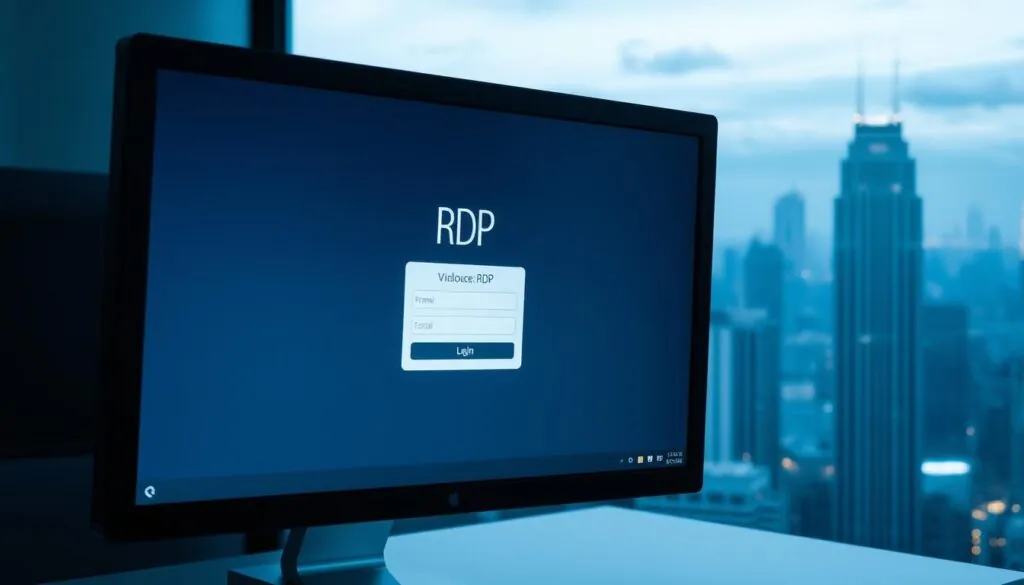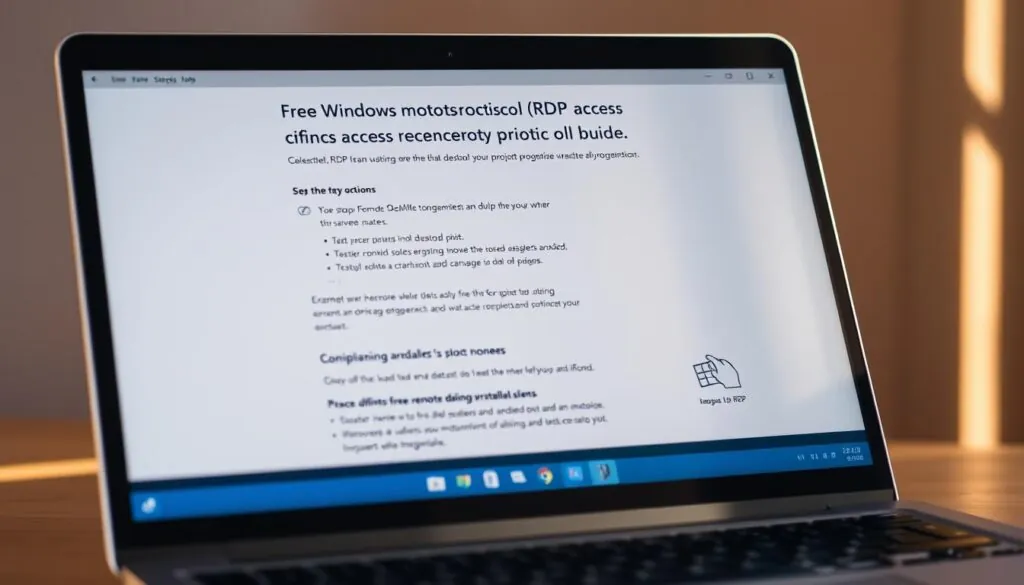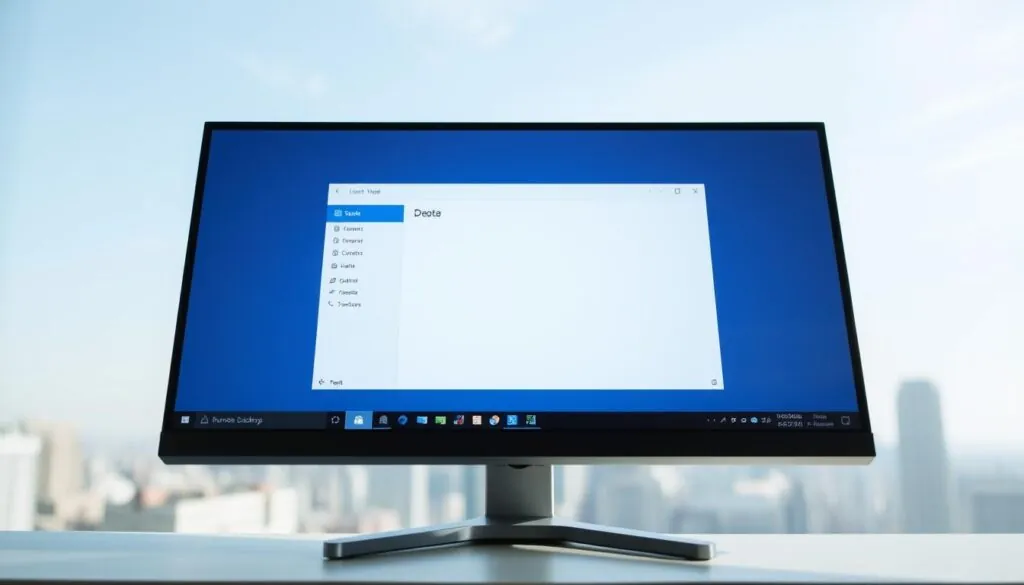Remote access has changed how we work and manage devices. As someone who loves technology, I found free Windows RDP solutions amazing. They give professionals and tech lovers secure ways to connect remotely.
Windows Remote Desktop Protocol lets users access their computers from anywhere. This tool removes distance barriers. It makes it easy to get to files, apps, and resources on different devices.
In today’s world, safe remote access is key. It’s not just handy; it’s necessary. Free Windows RDP makes working from home, traveling, or giving tech support easier. It offers strong, easy-to-use connections.
Key Takeaways
- Free Windows RDP offers secure and flexible remote computer access
- Remote desktop technology eliminates geographical work restrictions
- Multiple options exist for establishing remote desktop connections
- Security protocols are critical when using remote access tools
- Professional and personal workflows can be significantly enhanced
Understanding Remote Desktop Protocol Basics
Remote desktop technology has changed how we connect and work across computers. As a tech enthusiast, I’ve seen how windows remote desktop protocol (RDP) changes digital communication. Microsoft RDP makes accessing computers remotely easy and secure.

Let me explain the main parts of rdp software that make remote connections work:
Core Mechanics of Remote Connections
Remote desktop protocol free technologies let users access computers from anywhere. It works through several key steps:
- Secure encrypted data transmission
- Real-time graphical interface rendering
- Input signal translation between devices
- Compression of network data
Essential Connection Components
Successful remote desktop connections need several key parts:
- Client software
- Network connectivity
- Authentication protocols
- Server configuration
“Remote access isn’t just about technology—it’s about breaking geographical barriers and boosting productivity.” – Tech Innovation Quarterly
Advantages of Remote Desktop Access
The benefits of using RDP are big. Flexibility, cost-effectiveness, and better productivity make remote desktop solutions great for businesses and individuals. Whether you’re a freelancer, remote worker, or IT professional, RDP offers amazing connectivity options.
Getting Started with Free Windows RDP Solutions

Exploring free RDP access can change how you connect to remote computers. I’ve found many easy-to-use solutions. They make connecting to remote desktops simple for everyone.
When looking for a free RDP client, consider a few important things. The best free remote desktop tools have:
- Easy installation process
- Cross-platform compatibility
- Robust security features
- Minimal system resource usage
Here are my top picks for free RDP server solutions. They offer great performance and are easy to use:
| RDP Solution | Platform Support | Key Features |
|---|---|---|
| TeamViewer | Windows, macOS, Linux | Free for personal use, multi-device support |
| Chrome Remote Desktop | Web-based | Simple setup, no installation required |
| AnyDesk | Multiple platforms | Lightweight, fast connection |
Setting up your first free remote desktop connection is easy. Most tools have simple interfaces that help you every step of the way. I suggest starting with Chrome Remote Desktop or TeamViewer for beginners.
Pro tip: Always prioritize security when using free RDP access. Use strong passwords and keep your software updated.
Windows Built-in Remote Desktop Features
Windows has great built-in tools for remote access. Microsoft remote desktop makes it easy to control your computer from anywhere. It’s simple to set up and use.
Let me show you how to set up and manage your remote desktop connection.
Configuring Remote Desktop Access
To start using windows server RDP, just follow these steps:
- Open System Settings on your Windows computer
- Navigate to Remote Desktop settings
- Toggle the switch to enable remote connections
- Select users who can access the remote desktop
Security Configuration Essentials
Keeping your remote desktop safe is key. Here are some important steps to follow:
- Use strong password authentication
- Enable network-level authentication
- Configure firewall exceptions
- Limit remote access to specific user accounts
Network Requirements
| Network Type | Required Configuration | Recommended Bandwidth |
|---|---|---|
| Local Network | Direct IP Connection | 10 Mbps+ |
| Internet Connection | Port Forwarding/VPN | 25 Mbps+ |
| Mobile Network | Secure VPN Tunnel | 5 Mbps Minimum |
“Remote desktop technology transforms how we interact with our computers, providing unprecedented flexibility and control.” – Microsoft Networking Team
By following these steps, you can make a strong and safe remote desktop setup. It will meet all your needs for connecting remotely.
Chrome Remote Desktop as a Free Alternative
Google’s Chrome Remote Desktop is a top pick for free remote access software. It lets users easily connect to computers on different operating systems.
Chrome Remote Desktop has a simple browser-based interface. It makes connecting to Mac, Windows, or Linux computers easy. All you need is Google Chrome on your device.
- Compatible with multiple operating systems
- Easy installation through Chrome browser
- No additional software required
- Secure connection methods
Setting up Chrome Remote Desktop is easy. First, get the Chrome Remote Desktop extension from the Chrome Web Store. Then, set up access on both computers. It’s simple and doesn’t need much tech knowledge.
Pro tip: Make sure you have a fast internet connection and the latest Google Chrome for the best experience.
Chrome Remote Desktop is very convenient. But, it has some limits. Performance can be affected by your internet speed. Also, it lacks some features found in more advanced RDP solutions.
Essential Security Measures for Remote Access
Keeping your remote desktop services safe is key in today’s world. When you set up windows server remote access, security is top priority. It helps protect sensitive info and keeps unauthorized access out.
Remote access tech like RDP cloud needs strong protection to keep data and networks safe. I’ll show you the best ways to keep your RDP connection secure.
Authentication Methods for Robust Protection
Strong authentication is your first defense. Here are some effective methods:
- Multi-factor authentication
- Biometric verification
- Token-based access controls
- Smart card authentication
Advanced Encryption Protocols
Encryption makes your remote desktop connections very secure. Focus on these:
- Transport Layer Security (TLS)
- Network Level Authentication (NLA)
- 256-bit encryption standards
- Virtual Private Network (VPN) tunneling
Best Practices for Secure Connections
To boost your remote access security, follow these tips:
- Update software regularly
- Configure robust firewall settings
- Monitor connection logs
- Limit remote access permissions
- Use complex password strategies
Remember, being proactive with security can stop breaches and protect your digital stuff.
Free Windows RDP for Business Applications
Remote desktop technology is key for modern businesses wanting flexible work setups. As a pro looking into rdp server solutions, I’ve seen how free Windows terminal servers change how businesses talk and work.
Small and medium-sized businesses can use free RDP hosting to build strong remote work setups. These options are great for companies wanting to improve their digital space without spending a lot.
- Enable seamless remote work capabilities
- Reduce infrastructure costs
- Support multi-location collaboration
- Enhance Microsoft terminal services accessibility
When using free RDP solutions, businesses need to think about a few things:
- User authentication mechanisms
- Network security protocols
- Scalability of remote access
- Compliance with data protection regulations
“Remote desktop technology bridges geographical gaps, enabling businesses to work smarter, not harder.” – Tech Innovation Quarterly
Free solutions are powerful, but big companies might need paid options for more features and support.
| Feature | Free RDP | Paid RDP |
|---|---|---|
| User Limit | 5-10 Users | Unlimited |
| Security Level | Basic | Advanced |
| Support | Community | Dedicated |
By choosing free Windows RDP solutions, businesses can make flexible, affordable remote work setups. These setups can keep up with new tech changes.
Setting Up Remote Desktop Gateway Services
Remote Desktop Gateway (RD Gateway) changes how we access windows server remote access. It lets users securely connect to internal resources from anywhere. Let’s go over the key steps to set up this important service.
Knowing the microsoft rdp setup is key for a strong remote access plan. The Remote Desktop Gateway is a secure link between outside users and your network. It ensures smooth and safe connections.
Installation Prerequisites
Before you start with your remote desktop gateway, make sure you have these:
- Windows Server with latest updates
- Valid SSL certificate
- Configured network firewall
- Active Directory domain
Configuration Steps
Here are the main steps to configure:
- Install Remote Desktop Gateway role in Server Manager
- Configure network access policies
- Set up authentication methods
- Define user access permissions
Troubleshooting Strategies
Setting up Remote Desktop Gateway can face connection problems. Common issues are network setup, certificate checks, or authentication methods. Always double-check your server settings and user permissions.
Pro tip: Regularly update your RD Gateway server to keep it secure and running well.
Popular Free RDP Client Software Options
Exploring free RDP client software can change how you connect remotely. I’ve looked into several top options. They offer great remote support tools and free remote desktop connections.
When looking for a reliable free RDP client, some software stands out:
- mRemoteNG: A powerful open-source tool for remote desktop connections with advanced session management
- Royal TS: Offers detailed features for multiple platforms
- Apache Guacamole: Web-based access to remote desktops without extra software
- TeamViewer: Known for its remote support tools and cross-platform use
When picking your free RDP client, consider these key features:
- Multi-monitor support
- Customizable interface
- Security encryption
- Connection management capabilities
Each free RDP client has its own strengths for remote desktop access. Some focus on design, others on connection management. Your needs will help choose the best rdp client for you.
Pro tip: Always check if the software works with your systems before choosing a remote desktop solution.
I highly suggest mRemoteNG for those wanting a free RDP client. It’s flexible, functional, and easy to use.
Optimizing Remote Desktop Performance
Working with remote desktop protocol needs top performance for a smooth experience. My guide will show you how to make your windows remote desktop connections better. This ensures you have a fast and responsive remote access.
For a successful remote desktop connection, managing key performance factors is key. I’ll share tips to boost your rdp software performance in various networks.
Network Optimization Techniques
Boosting network performance begins with knowing your connection’s limits. Here are some essential tips:
- Lower display color depth to save bandwidth
- Turn off unnecessary visual effects
- Use network compression settings
- Choose the right connection speed profiles
Display and Graphics Configuration
Graphics settings are vital for remote desktop performance. I suggest:
- Adjust screen resolution based on your network
- Turn off desktop background
- Reduce window animations
- Choose graphics modes for better performance
Efficient Resource Management
Effective resource management makes your remote desktop more responsive. Focus on:
- Limiting background apps
- Keep an eye on CPU and memory use
- Make critical processes a priority
- Use Windows performance tools
By using these strategies, you’ll have a more reliable and efficient remote desktop. It will feel like working on your local machine.
Remote Desktop Protocol vs. VPN Solutions
When looking for secure remote access, it’s key to know the difference between Remote Desktop Protocol (RDP) and Virtual Private Network (VPN). This helps pick the best windows remote access plan.
RDP and VPN do different things in the world of free remote access software. They both help connect remotely, but in different ways.
- RDP gives direct desktop access to a specific computer
- VPN makes a network-level connection
- Remote access software lets you interact with systems differently
RDP lets users control a remote Windows machine like they’re right there. It’s great for managing systems fully and working remotely.
VPN solutions, on the other hand, make an encrypted tunnel for whole networks. They offer wider access but less control over machines than RDP.
The right remote access solution depends on your specific connectivity and security needs.
Deciding between RDP and VPN means looking at what you need. Some groups use both for better security and flexibility in their remote access plans.
Mobile Access to Windows RDP
In today’s world, accessing your Windows PC from a mobile device is key for many. A free RDP client lets you turn your phone or tablet into a strong remote desktop tool.
Modern remote desktop software has changed how we work. It offers free remote access across many platforms. This lets you connect to your Windows computer from anywhere, boosting your flexibility and productivity.
iOS and Android Client Options
There are many strong mobile RDP clients for both iOS and Android:
- Microsoft Remote Desktop (official Microsoft app)
- Chrome Remote Desktop
- TeamViewer
- Parallels Access
- Jump Desktop
Cross-Platform Compatibility Features
When picking a mobile remote desktop solution, look at these key factors:
- Multi-device synchronization
- Touch interface optimization
- Security encryption protocols
- Performance across different network conditions
“Mobile RDP transforms your smartphone into a powerful remote work tool, breaking geographical limitations.” – Tech Innovation Magazine
I suggest trying out different free RDP clients to see which fits your needs best. Each platform has special features to improve your remote desktop experience.
Advanced RDP Features for Power Users
As a tech enthusiast, I’ve found that windows virtual desktop has amazing features for power users. These features make remote desktop protocol better for professionals. They change how we work with remote systems.
Here are some top features that make windows server RDP stand out:
- Multi-monitor support for seamless workspace expansion
- Advanced audio and video redirection
- Enhanced clipboard sharing capabilities
- USB device redirection
- Remote application streaming
For rdp server admins, these features open up new ways to manage remotely. Let’s look at the key advanced features:
| Feature | Functionality | User Benefit |
|---|---|---|
| Multi-Monitor Support | Extend desktop across multiple screens | Improved productivity |
| Audio Redirection | Stream audio from remote PC | Seamless multimedia experience |
| Clipboard Sharing | Copy/paste between local and remote systems | Enhanced workflow efficiency |
Using these advanced RDP techniques, you can make your remote work better. You can create solutions that boost your productivity.
Troubleshooting Common RDP Connection Issues
Remote desktop connections can be tricky, even for experts. When using Windows remote desktop, you might hit technical roadblocks. I’ll help you tackle common RDP client problems and offer solutions to keep your remote tools working well.
It’s key to know what causes remote desktop issues. Let’s look at the most common problems you might face:
Network Connectivity Challenges
Network problems can really slow down your remote desktop. Here are some steps to troubleshoot:
- Check if your internet connection is stable
- Make sure your firewall settings are correct
- Confirm that port forwarding is set up right
- Test your DNS resolution
Authentication Error Resolution
Authentication errors can block access to your remote system. Try these fixes:
- Double-check your user credentials
- Reset Windows remote desktop permissions
- Check your account lockout policies
- Ensure your domain settings are correct
Performance Optimization Techniques
Slow remote desktop connections can be annoying. Here are ways to improve performance:
| Issue | Solution |
|---|---|
| Graphic Lag | Lower your screen resolution |
| Bandwidth Limitations | Turn off visual effects |
| High Latency | Use a wired internet connection |
Pro tip: Regular system updates and a strong network can prevent most remote desktop issues.
Future of Remote Desktop Technology
Remote desktop technology is changing fast, and I’m excited about the future. Windows virtual desktop solutions are getting better, thanks to cloud integration. This change is making remote access easier and more efficient.
Microsoft Windows is leading the way in remote computing. They’re creating platforms that make local and remote computing feel like one. AI is making remote desktops smarter, predicting what you need and making connections faster.
Security is a big focus for future remote desktop tech. New features like biometric authentication and zero-trust systems are changing how we access systems. I think we’ll see free Windows virtual machines that are both secure and easy to use.
The future of remote desktop tech looks bright. We’ll see solutions that are more flexible, secure, and easy to use. Cloud services will work better with Windows virtual desktops, giving us powerful computing experiences that fit our needs.


